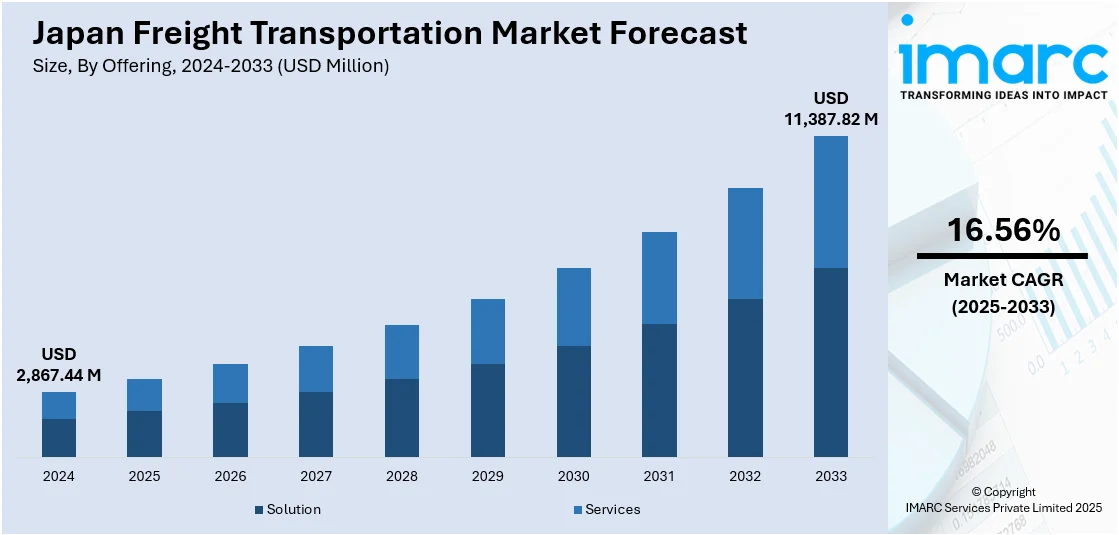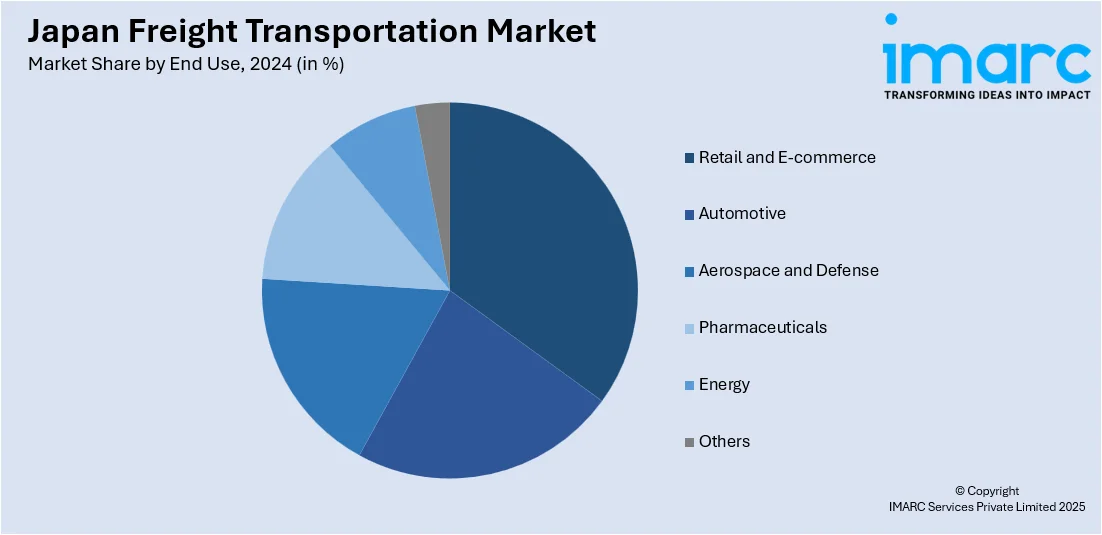
Japan Freight Transportation Market Size, Share, Trends and Forecast by Offering, Transport, End Use, and Region, 2025-2033
Japan Freight Transportation Market Overview:
The Japan freight transportation market size reached USD 2,867.44 Million in 2024. Looking forward, IMARC Group expects the market to reach USD 11,387.82 Million by 2033, exhibiting a growth rate (CAGR) of 16.56% during 2025-2033. The market is driven by technological advancements in logistics, enhancing effectiveness and lowering costs through automation and artificial intelligence. Increasing demand from e-commerce and international trade promotes increased volumes of cargo, particularly in small parcels and international freight, hence propelling the industry. Support through regulations and infrastructure upgrades also has a defining role, facilitating efficient transport and promoting investments, further augmenting the Japan freight transportation market share.
|
Report Attribute
|
Key Statistics
|
|---|---|
|
Base Year
|
2024 |
|
Forecast Years
|
2025-2033
|
|
Historical Years
|
2019-2024
|
| Market Size in 2024 | USD 2,867.44 Million |
| Market Forecast in 2033 | USD 11,387.82 Million |
| Market Growth Rate 2025-2033 | 16.56% |
Japan Freight Transportation Market Trends:
E-Commerce Growth and Global Trade
The market is significantly influenced by the growing demand for e-commerce and the continued expansion of global trade networks. Considerable rise in online shopping has led to an increase in shipments, particularly those involving small and medium-sized parcels that require frequent delivery. Additionally, Japan's strategic location as a hub for international shipping between Asia and other global markets makes it an essential player in the movement of goods. Automation, digitization, and the use of AI-driven systems are improving efficiency and reducing operational costs. Innovations such as autonomous vehicles, smart warehouses, and predictive analytics are enabling companies to optimize routes, streamline inventory management, and reduce transit times. Furthermore, digital platforms are enhancing transparency in supply chains, offering real-time tracking and status updates. As companies increasingly adopt these technologies, they can offer more reliable and cost-effective services to clients, which enhances the overall efficiency of the system. On November 3, 2024, Japan announced plans to launch an automated cargo transport system between Tokyo and Osaka to address the severe truck driver shortage. The system, which will use large, wheeled vehicles on a dedicated three-lane highway, aims to reduce the 34% projected drop in transport capacity by 2030, as 91% of Japan’s 4.3 billion metric tons of cargo are currently moved by trucks. With trial runs planned for 2027 and full operation by the mid-2030s, this initiative will help alleviate pressure from the 60% of households now engaged in online shopping, a rise from 40% during the COVID-19 pandemic. The expansion of trade agreements, particularly in the Asia-Pacific region, is contributing to an increase in the volume of cargo handled, thereby enhancing transportation demand. This is reflected in the growing need for integrated logistics services, which cater to the intricate requirements of modern supply chains. These factors contribute to the overall Japan freight transportation market growth.

Regulatory Support and Infrastructure Development
Government initiatives in Japan have contributed to the growth of the market through regulatory frameworks and investment in infrastructure. The Japanese government has emphasized the importance of modernizing transportation networks, with initiatives focusing on enhancing port facilities, improving roads, and developing high-speed rail systems for cargo transport. Additionally, regulatory reforms aimed at improving environmental sustainability have driven the adoption of more fuel-efficient, low-emission transport solutions. On February 27, 2025, Nippon Express signed an agreement with Nikon Corporation to provide air cargo transport services using Sustainable Aviation Fuel (SAF). This collaboration is part of the Tokyo Metropolitan Government’s initiative to promote SAF use, with Nippon Express issuing CO2 reduction certificates for Nikon’s air cargo, reducing Scope 3 emissions. Nippon Express is committed to reducing its Scope 1 and Scope 2 emissions by 50% from 2013 levels by 2030 and achieving carbon-neutral societies by 2050 across all emissions scopes. The Tokyo Metropolitan Government’s SAF usage project will subsidize the additional costs of using SAF for air cargo until March 2025, further supporting Nippon Express’s sustainability efforts. The government’s push to improve transportation efficiency and reduce congestion in key areas has encouraged private sector investments, leading to a more sophisticated and competitive market landscape. This strategic infrastructure development further supports the market’s expansion. The continuous integration of advanced technologies into Japan's freight transportation industry plays a central role in shaping market dynamics. The need for enhanced accuracy, speed, and resource management will continue to push the development of these technologies, further promoting market expansion.
Japan Freight Transportation Market Segmentation:
IMARC Group provides an analysis of the key trends in each segment of the market, along with forecasts at the country and regional levels for 2025-2033. Our report has categorized the market based on offering, transport, and end use.
Offering Insights:
- Solution
- Freight Transportation Cost Management
- Freight Mobility Solution
- Freight Security and Monitoring System
- Freight Information Management System
- Fleet Tracking and Maintenance Solution
- Freight Operational Management Solutions
- Freight 3PL Solution
- Warehouse Management System
- Services
The report has provided a detailed breakup and analysis of the market based on the offering. This includes solution (freight transportation cost management, freight mobility solution, freight security and monitoring system, freight information management system, fleet tracking and maintenance solution, freight operational management solutions, freight 3PL solution, and warehouse management system) and services.
Transport Insights:
- Roadways
- Railways
- Waterways
- Airways
The report has provided a detailed breakup and analysis of the market based on the transport. This includes roadways, railways, waterways, and airways.
End Use Insights:

- Retail and E-commerce
- Automotive
- Aerospace and Defense
- Pharmaceuticals
- Energy
- Others
The report has provided a detailed breakup and analysis of the market based on the end use. This includes retail and e-commerce, automotive, aerospace and defense, pharmaceuticals, energy, and others.
Regional Insights:
- Kanto Region
- Kansai/Kinki Region
- Central/Chubu Region
- Kyushu-Okinawa Region
- Tohoku Region
- Chugoku Region
- Hokkaido Region
- Shikoku Region
The report has also provided a comprehensive analysis of all major regional markets. This includes Kanto Region, Kansai/Kinki Region, Central/Chubu Region, Kyushu-Okinawa Region, Tohoku Region, Chugoku Region, Hokkaido Region, and Shikoku Region.
Competitive Landscape:
The market research report has also provided a comprehensive analysis of the competitive landscape. Competitive analysis such as market structure, key player positioning, top winning strategies, competitive dashboard, and company evaluation quadrant has been covered in the report. Also, detailed profiles of all major companies have been provided.
Japan Freight Transportation Market News:
- On January 27, 2025, Fujitsu and Sustainable Shared Transport (SST), a subsidiary of Yamato Holdings, launched a joint delivery and transportation system aimed at improving logistics efficiency across numerous end-use industries in Japan. Starting on February 1, the platform integrates standardized pallet transportation and digital information exchange, optimizing transportation plans and reducing empty mileage. This initiative, backed by Fujitsu's blockchain technology for secure data sharing, will expand to include rail and sea freight by 2026.
- On February 23, 2025, Japan’s East Japan Railway Co. (JR East) announced Japan's first cargo-only bullet train, set to launch in the fall, connecting Tokyo and Morioka. The modified E3 Shinkansen will transport goods like precision equipment and fresh fish, offering faster, more efficient service than standard cargo trains. This marks the first dedicated freight Shinkansen since the Tokaido Shinkansen's debut in 1964.
Japan Freight Transportation Market Report Coverage:
| Report Features | Details |
|---|---|
| Base Year of the Analysis | 2024 |
| Historical Period | 2019-2024 |
| Forecast Period | 2025-2033 |
| Units | Million USD |
| Scope of the Report |
Exploration of Historical Trends and Market Outlook, Industry Catalysts and Challenges, Segment-Wise Historical and Future Market Assessment:
|
| Offerings Covered |
|
| Transports Covered | Roadways, Railways, Waterways, Airways |
| End Uses Covered | Retail and E-commerce, Automotive, Aerospace and Defense, Pharmaceuticals, Energy, Others |
| Regions Covered | Kanto Region, Kansai/Kinki Region, Central/Chubu Region, Kyushu-Okinawa Region, Tohoku Region, Chugoku Region, Hokkaido Region, Shikoku Region |
| Customization Scope | 10% Free Customization |
| Post-Sale Analyst Support | 10-12 Weeks |
| Delivery Format | PDF and Excel through Email (We can also provide the editable version of the report in PPT/Word format on special request) |
Key Questions Answered in This Report:
- How has the Japan freight transportation market performed so far and how will it perform in the coming years?
- What is the breakup of the Japan freight transportation market on the basis of offering?
- What is the breakup of the Japan freight transportation market on the basis of transport?
- What is the breakup of the Japan freight transportation market on the basis of end use?
- What is the breakup of the Japan freight transportation market on the basis of region?
- What are the various stages in the value chain of the Japan freight transportation market?
- What are the key driving factors and challenges in the Japan freight transportation market?
- What is the structure of the Japan freight transportation market and who are the key players?
- What is the degree of competition in the Japan freight transportation market?
Key Benefits for Stakeholders:
- IMARC’s industry report offers a comprehensive quantitative analysis of various market segments, historical and current market trends, market forecasts, and dynamics of the Japan freight transportation market from 2019-2033.
- The research report provides the latest information on the market drivers, challenges, and opportunities in the Japan freight transportation market.
- Porter's five forces analysis assist stakeholders in assessing the impact of new entrants, competitive rivalry, supplier power, buyer power, and the threat of substitution. It helps stakeholders to analyze the level of competition within the Japan freight transportation industry and its attractiveness.
- Competitive landscape allows stakeholders to understand their competitive environment and provides an insight into the current positions of key players in the market.
Need more help?
- Speak to our experienced analysts for insights on the current market scenarios.
- Include additional segments and countries to customize the report as per your requirement.
- Gain an unparalleled competitive advantage in your domain by understanding how to utilize the report and positively impacting your operations and revenue.
- For further assistance, please connect with our analysts.
 Request Customization
Request Customization
 Speak to an Analyst
Speak to an Analyst
 Request Brochure
Request Brochure
 Inquire Before Buying
Inquire Before Buying




.webp)




.webp)












